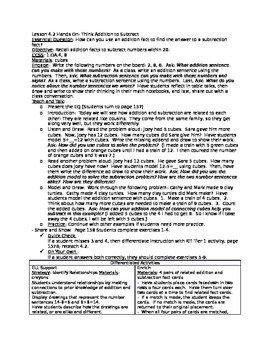First Grade- Go Math!- Chapter 4- Lesson Plans
Highly Effective Teaching with MrsLefko
162 Followers
Grade Levels
1st
Subjects
Resource Type
Standards
CCSS1.OA.A.1
CCSS1.OA.B.4
CCSS1.OA.C.5
CCSS1.OA.C.6
Formats Included
- Word Document File
Pages
12
Highly Effective Teaching with MrsLefko
162 Followers
Description
UDATED for the 2015 version of Go Math!
As a Common Core Fellow for the NYCDOE, and as a facilitator for a Go Math! Implementation course for lead teachers, I have a thorough understanding of the Common Core State Standards, Standards for Mathematical Practice, and the key shifts. My lesson plans are intricately planned with all of these essential components in mind. I look at the Go Math! recommendations and make strategic adjustments to ensure that all are given appropriate weight, while also adding scaffolds. They have the appropriate level of scaffolds and rigor for students in any school, and any classroom setting, as they are intended for my class that contains about 40% students with special needs, 60% general education students, and multiple English Language Learners. The lessons plans will download in Word so they can be edited to your liking. Search my store for the corresponding Smart Board lessons.
Danielson Framework Alignment:
1a: Demonstrating Knowledge of Content and Pedagogy
1e: Designing Coherent Instruction
This document contains detailed plans for the 6 lessons for this chapter, along with a plan for Show What You Know, the chapter test, and performance task.
As a Common Core Fellow for the NYCDOE, and as a facilitator for a Go Math! Implementation course for lead teachers, I have a thorough understanding of the Common Core State Standards, Standards for Mathematical Practice, and the key shifts. My lesson plans are intricately planned with all of these essential components in mind. I look at the Go Math! recommendations and make strategic adjustments to ensure that all are given appropriate weight, while also adding scaffolds. They have the appropriate level of scaffolds and rigor for students in any school, and any classroom setting, as they are intended for my class that contains about 40% students with special needs, 60% general education students, and multiple English Language Learners. The lessons plans will download in Word so they can be edited to your liking. Search my store for the corresponding Smart Board lessons.
Danielson Framework Alignment:
1a: Demonstrating Knowledge of Content and Pedagogy
1e: Designing Coherent Instruction
This document contains detailed plans for the 6 lessons for this chapter, along with a plan for Show What You Know, the chapter test, and performance task.
Total Pages
12
Answer Key
Does not apply
Teaching Duration
2 Weeks
Last updated Oct 26th, 2014
Report this resource to TPT
Reported resources will be reviewed by our team. Report this resource to let us know if this resource violates TPT’s content guidelines.
Standards
to see state-specific standards (only available in the US).
CCSS1.OA.A.1
Use addition and subtraction within 20 to solve word problems involving situations of adding to, taking from, putting together, taking apart, and comparing, with unknowns in all positions, e.g., by using objects, drawings, and equations with a symbol for the unknown number to represent the problem.
CCSS1.OA.B.4
Understand subtraction as an unknown-addend problem. For example, subtract 10 – 8 by finding the number that makes 10 when added to 8.
CCSS1.OA.C.5
Relate counting to addition and subtraction (e.g., by counting on 2 to add 2).
CCSS1.OA.C.6
Add and subtract within 20, demonstrating fluency for addition and subtraction within 10. Use strategies such as counting on; making ten (e.g., 8 + 6 = 8 + 2 + 4 = 10 + 4 = 14); decomposing a number leading to a ten (e.g., 13 - 4 = 13 - 3 - 1 = 10 - 1 = 9); using the relationship between addition and subtraction (e.g., knowing that 8 + 4 = 12, one knows 12 - 8 = 4); and creating equivalent but easier or known sums (e.g., adding 6 + 7 by creating the known equivalent 6 + 6 + 1 = 12 + 1 = 13).



